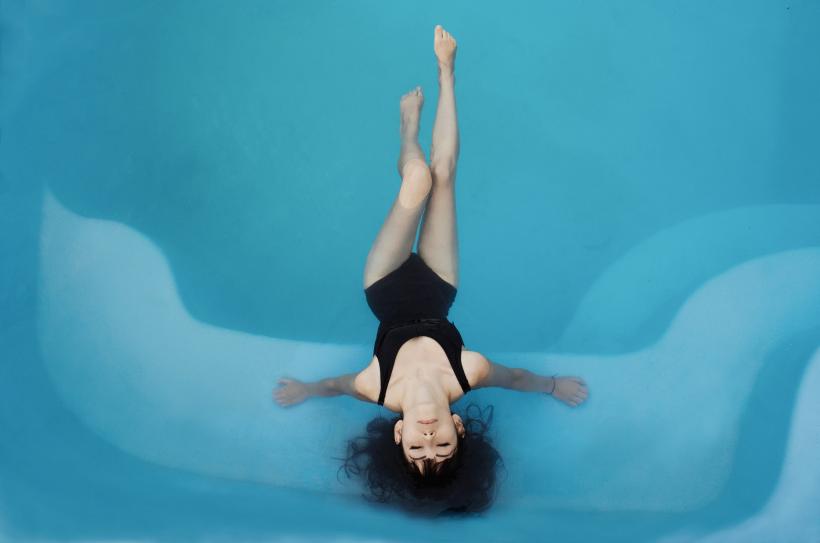
Sensory deprivation provided me with a way to relate to my body that was rooted in acceptance. Image: Camila Cordeiro/Unsplash.
Sensory deprivation didn’t cure my issues with my body, but my body and I came to a truce, even if only for that day in the spa.
On the Saturday afternoon drive over to FLOAT Annapolis, I’m more nervous than I should be for a day trip to the spa.
Well, except that this isn’t the kind of spa where I’ll lounge with a cup of tea as I wait for my massage or pedicure.
It’s the kind of spa where the relaxation has to come from within me — and, frankly, I’m not a person who relaxes all that easily.
Sensory deprivation spas (also known as “float spas”) offer 60- to 90-minute individual sessions to float on your back in a pool of warm water (typically 95° F) mixed with Epsom salt. The dense saltwater is placed within a completely dark, soundproof chamber intended to encourage meditation and creativity.
I’d seen the episode of The Simpsons where Lisa and Homer try sensory deprivation years ago, back when I found the whole scenario amusing, if somewhat claustrophobia-inducing. I pictured the sensory deprivation tanks as coffins, sealing me in for the kind of misadventure Homer endures when his tank is taken by repo men and falls out of their moving van, only to wash up on the beach (still in the tank!) and then be returned to the spa without ever knowing he left the premises.
His story seemed more like a cautionary tale than an endorsement.
I didn’t think about sensory deprivation tanks again until my spring writer’s workshop in Asheville, NC with Ariel Gore. After a day of coffee, impromptu writing prompts and sharing feedback, one of the workshop participants brought up her sensory deprivation tank experience over dinner.
I peppered her with questions, curious to see if her story was anything like the cartoon. Her genuine enthusiasm won me over, and when I returned home from the weekend, I found a spa and booked my appointment.
When I arrived at Float Spa, the front-desk person walked me over to the chamber and provided me with towels and ear plugs. “Are you a first-time floater?” she asked — and I laughed before nodding.
Behind her stood a shower head and three kinds of herbal shampoo. She told me to take a shower before entering the chamber and asked if I wanted some music to start off my session.
Eager for any stimulation that would guide me through the experience, I said yes.
She also warned me not to float on my stomach, since I’d be likely to sting my eyes with saltwater. As soon as I turned off the shower, that would be her cue to start the music.
My chamber seemed more like an extended shower stall, wide enough for me to float in and move around. I’d enter and exit the pool through a door that I could push open at any time; there was actually no need to panic about being trapped in the tank.
Once she closed the door, I tied my hair back and took a few deep breaths, then turned on the shower. I didn’t bother drying off, since I would be stepping into the pool, but I did make sure there weren’t any residual soap suds stuck to my skin (the chemicals in soap are likely to mess with the pH of the tank).
The speakers piped in soft classical music as I opened the door to the chamber. I stepped in gingerly and the water came up to my calves, warm and soothing. I closed the door and lowered myself into the tank.
In a space without light or sound or other people, I could react to my body on my own terms.
In the dark, I folded my arms behind my head to cradle my neck and prevent stiffness. I realized I had more than enough room to push myself around the tank while floating on my back. With the soles of my feet, I pushed myself off the wall, then back again with my hands when I touched the opposite side.
I thought about the summers working as a lifeguard in high school and college. I’d always savored those days when I had the entire pool to myself, free to swim laps or relax in the shallow end with a book perched carefully above the waterline.
In the tank, however, I couldn’t distract myself with either of those activities. Naturally, my mind wandered.
A year ago, I wrote about how I don’t want strangers or friends to tell me they’re “proud” to see me exercise. But in a space without light or sound or other people, I could react to my body on my own terms. I felt the salt particles on the soft mounds of my belly — a part of my body that all of the best feminist theories and body-positive ideals haven’t helped me to find peace with.
But in the tank, I could touch the salt on my stomach without feeling shame. The textures of salt and skin calmed me — I didn’t get caught up in the body dysmorphia that never fails to give me anxiety over my weight.
Sensory deprivation provided me with a way to relate to my body that was rooted in acceptance: This is me, this is what I feel like, and this is all OK.
I never quite drifted off to sleep, but I did emerge from the session with a drowsy sense of pleasure. I washed the salt off and studied myself in the mirror, the soft, imperfect body I’d regarded so fondly in the dark.
And then — not pinching, not frowning — I moved my hands over my hips and stomach with the same curious sense of wonder I’d felt in the tank.
Sensory deprivation didn’t cure my issues with my body, but my body and I came to a truce, even if only for that day in the spa.
I know I’ll be back to the tank again: eyes open, fully present in my skin.







